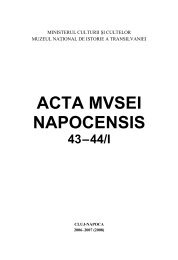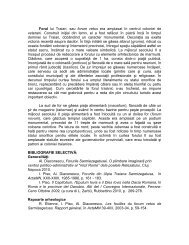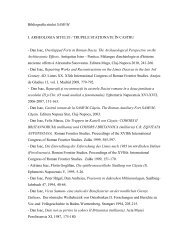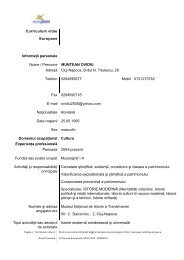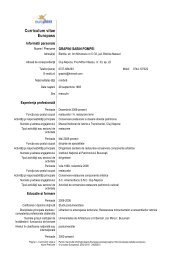41-42/I – Archeology - Muzeul Naţional de Istorie a Transilvaniei
41-42/I – Archeology - Muzeul Naţional de Istorie a Transilvaniei
41-42/I – Archeology - Muzeul Naţional de Istorie a Transilvaniei
Create successful ePaper yourself
Turn your PDF publications into a flip-book with our unique Google optimized e-Paper software.
24<br />
Gheorghe GâŃă, Alexandru Dragoman<br />
it. If the clay had too many large quartz granules, (s)he used it only for surfaceroughened<br />
pots. When mo<strong>de</strong>lling the bottom of a surface-roughened pot (s)he ma<strong>de</strong> it as<br />
roun<strong>de</strong>d as possible, by thickenning the adjacent portion between the bottom and body<br />
of the pot. In the case of the burnished pottery, the interior surface treatment (burnishing)<br />
was more rigorous for the plain burnished and channelled pots, and more superficial for<br />
the excised pots, which suggests that the excised pots were not used for liquids or food<br />
that could have stuck to the rough spots of the inner walls. The bodies of the pots were<br />
mo<strong>de</strong>lled and evened in a similar manner for the entire Vădastra pottery. After a<br />
thorough tempering of the clay with water <strong>–</strong> with a view to obtaining a consistent paste <strong>–</strong><br />
they used to flatten the clay ball and add cut vegetal mass as a <strong>de</strong>greaser. Then, the<br />
paste was fol<strong>de</strong>d more times, so that as few as possible remains of plants appeared at<br />
the surface of the flattened patch. After the mo<strong>de</strong>lling and evening of the bottom, the<br />
newly tempered flattened patch was laid upon the adjacent margins of the bottom, the<br />
wall of the pot was pressed and mo<strong>de</strong>lled. The potter bore in mind first of all the<br />
proportion of <strong>de</strong>greasing addition to the clay as related to the thickness of the pots walls.<br />
Secondly, the potter used to proportion the thickness of the walls according to their<br />
diameter. The potters were not concerned with the evenness of the thickness of the pots<br />
walls, that were instinctively manufactured almost of the same thickness after the<br />
mo<strong>de</strong>lling.<br />
Finishing the pots for firing<br />
The pots were left to dry at the environmental temperature, laid on dry earth or<br />
on rugs. In a few cases, on the bottoms of the pots the pattern of the rugs was imprinted<br />
(see Fig. 3). After a partial drying, the fine pots were wetted by sprinkling them with a fine<br />
diluted suspension, ma<strong>de</strong> out of the same clay as the pots, and obtained by the<br />
sedimentation of the suspension, and the <strong>de</strong>cantation of the fine part. This way, at the<br />
surface of the pots a thin slip formed. Then, the pots were <strong>de</strong>corated. After being dried<br />
out, the pots were again sprinkled a little, and the un<strong>de</strong>corated surfaces were<br />
burnished/polished with smooth polishing stones. More often than not, these stones were<br />
of microcrystalline quartz, as proven by their X-ray diffraction diagrams. Then red ochre<br />
was applied, especially on the excised pottery <strong>41</strong> . Sometimes, on the ‘Vădastra 1’ pottery<br />
red colour was applied also after firing <strong>42</strong> . The white colour is given by the cut limy<br />
concretions, that the potters got from the Obârşia stream bed 43 .<br />
Firing<br />
Once finished and dried out, the pots were fired on open firing, in firing spaces<br />
with non-constant temperature, between 400 ˚C and 550 ˚C. The firing was incomplete,<br />
so that on the outsi<strong>de</strong> the pottery mass reached till 600 ˚C, while on the insi<strong>de</strong> it barely<br />
reached 200 ˚C in the pots with thick walls. These levels of temperature can be<br />
recognized by the constant occurrence of the 10 kX diffraction line <strong>de</strong>composing towards<br />
680 ˚C, the presence or lack of the infrared absorption band from 3690 em <strong>–</strong>1 of the<br />
kaolinite <strong>de</strong>composing at 450-500 ˚C and by the ratio of the intensity of the diffraction<br />
lines from 10 kX and 7.15 kX ranging between 100 ˚C and 450 ˚C. After firing and<br />
cooling, the pots were burnished/polished again, as proven by the lustre, and the<br />
orientation of the mica particles at the surface of the sherds. Unlike burnished pottery,<br />
many of the surface-roughened pots were fired secondarily unevenly, in oxidizing<br />
atmosphere, at temperatures over 550 ˚C.<br />
<strong>41</strong><br />
During the excavations ochre balls for pottery painting were found.<br />
<strong>42</strong><br />
GâŃă, Mateescu 1999-2001.<br />
43<br />
GâŃă, Mateescu 1987; 1992b.



